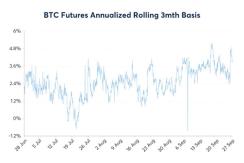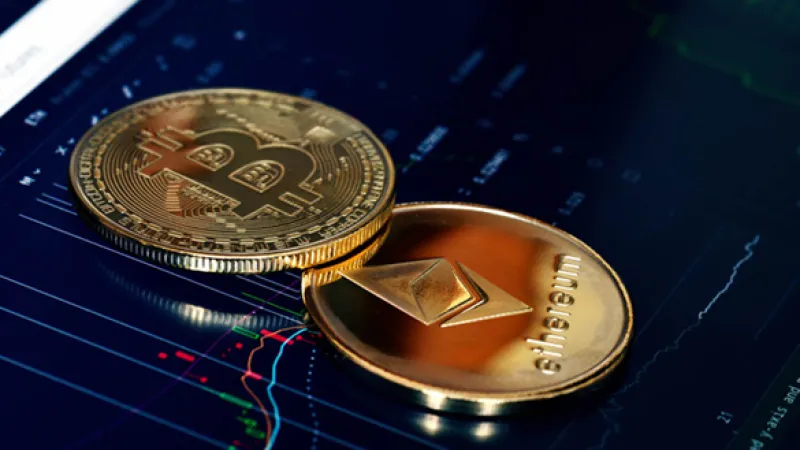Payal Shah, CME Group
AT A GLANCE
- Bitcoin and ether volatility have raised awareness of basis, the difference between spot and futures market prices
- Basis Trade at Index Close (BTIC) transactions provide a bridge between the spot cryptocurrency price and the corresponding futures market
CME Bitcoin futures, which typically trade at a premium to the spot price, retreated amid a significant selloff in June, and largely erased the basis trade, in which a trader would buy bitcoin in the spot market today and sell long-dated futures, locking in the discrepancy between the two prices.
Simply put, basis can be described as the difference between the spot price of an asset and its futures price.
Basis in crypto is constantly changing. If demand is strong and the available supply is small, spot prices could rise relative to futures prices, causing the basis to strengthen. This would be a negative basis with spot price trading lower than the futures price.
On the other hand, if demand is weak and a large supply is available, spot prices could fall relative to the futures price, causing the basis to weaken. The shape of the futures curve is important to hedgers and speculators, as it indicates where future prices may be headed. Typically, we see the crypto futures market in contango, where the price of a futures contract is higher than the spot price.

The basis trade involves buying spot crypto (taking a long position) and simultaneously establishing a short position through derivatives like options or futures contracts, or vice versa. Basis may fluctuate due to changes in supply and demand, but due to the forces of arbitrage, it will converge on expiry to zero.
Going long or short on a futures contract means that you can lock in the forward buying price or selling price of a futures contract on the assumption that you hold the contract until its delivery date. A futures price is based on its current spot price plus the cost of carry during the interim before delivery. The cost of carrying of a futures contract is represented by the basis.
Trading Basis in Crypto
BTIC allows participants to trade futures at a fixed spread to the closing underlying index level or reference rate. For CME Group crypto products, this index level is the transparent, regulated CME CF Reference Rates on Bitcoin and Ether (CME CF Bitcoin Reference Rate and Ether-Dollar Rate).BTIC transactions work when a buyer and seller agree to trade futures contracts, but instead of agreeing to a specific price, they agree to a spread, or basis, to be added to that day’s respective reference rate to determine the futures price. This basis is agreed upon before the day’s index level is known.
The relationship between spot and futures prices is important for miners and long-position HODLers as it informs their hedging decisions. The basis is used to gauge the value of the hedging strategy and is also used to search for arbitrage opportunities. It is often used by traders to determine the best time to buy or sell a crypto asset, where decisions are based on whether the basis is strengthening or weakening.
A wide range of other market participants may find BTIC a useful addition, including ETF providers to efficiently manage the creation or redemption process; structured product desks to effectively hedge transactions; relative value desks to more precisely trade the bitcoin basis; and institutional traders looking to transfer risk between the physical bitcoin and futures markets.
What Determines the Basis?
The value of the spread, or basis, depends on the futures implied financing rate, the time left to contract maturity, and perceived volatility among other factors.BTIC orders and transactions have their own unique tickers, providing market participants price discovery and transparency on the spread, or difference, between the price of the futures contract and the underlying index throughout the trading day.
BTIC is available for Bitcoin futures (BTC), Micro Bitcoin futures (MBT) and Ether futures (ETH). The BTIC order book is open 23-hours-a-day, allowing real-time price discovery in the futures basis as market participants around the globe submit orders against the respective cryptocurrency reference rate. Additionally, eligible contract participants may execute BTIC block trades 24/7 and submit for clearing during the appropriate clearing window. Whether trading on-screen or bilaterally, a wide range of market participants may use and benefit from the BTIC mechanism.
Turning Points
The Bitcoin futures basis, when watched carefully, can give market participants an indication of potential turning points in the market. Extreme contango could indicate bullish exuberance and may show the market is nearing a top. Backwardation, on the other hand, could indicate bearish sentiment and may signal potential buying opportunities. Keeping an eye on the basis can be very helpful when trading bitcoin and ether futures.Read more articles like this at OpenMarkets






